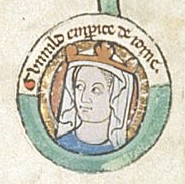|
County Of Verdun
The County of Verdun was a sovereign medieval county in the Duchy of Lower Lorraine. County The rulers of the sovereign County of Verdun styled themselves as Counts by the grace of God. The small country was located near Lower Lotharingia within the Holy Roman Empire. The Prince-Bishopric of Verdun bordered on it from the east. The Forest of Argonne formed the western border of the county, but it also included the fortresses at Montfaucon-d'Argonne and Vienne-le-Château. According to an imperial diploma issued in 1156, Bishop Haimo of Verdun received the right to appoint counts, but the counts from the Ardennes-Bouillon dynasty made the office hereditary by the end of the 10th century. List of counts *to 923 Ricwin, married first to the daughter of Engelram, Chamberlain to Charles the Bald, and second to Cunigunda, widow of Wigeric, Count of Bidgau *923–944 Otto, also duke of Lorraine from 940, son of Ricwin by his first marriage *944-963 Raoul, also Count of Ivois (as ... [...More Info...] [...Related Items...] OR: [Wikipedia] [Google] [Baidu] |
Duchy Of Lower Lorraine
The Duchy of Lower Lotharingia, also called Northern Lotharingia, Lower Lorraine or Northern Lorraine (and also referred to as '' Lothier'' or '' Lottier'' . In Davenport, Frances G. ''European Treaties Bearing on the History of the United States and Its Dependencies''. The Lawbook Exchange, Ltd., 2004. in titles), was a of the medieval established in 959, which encompassed almost all of modern , |
Gozlin, Count Of Bidgau And Methingau
Gozlin (c. 911 – between 19 October 942 and 16 February 943) was count of the Ardennes and the Bidgau. He was also army commander for his brother, Adalbero I of Metz. Gozlin was a son of Count Palatine Wigeric of Lotharingia and Cunigunda of France. In 930, he married Oda of Metz (905 – 10 April 963), a daughter of Count Gerard of Metz and Oda of Saxony. Through her mother Oda was a cousin of King Henry the Fowler of East Francia (Germany). Gozlin and Oda had the following children: *Reginar, count of Bastogne (d. 18 April 963). One of his sons was Adalberon (bishop of Laon). *Henry (d. 6 September 1000), Count of Arlon Arlon (; ; ; ) is a City status in Belgium, city and Municipalities in Belgium, municipality of Wallonia, and the capital of the Luxembourg (Belgium), province of Luxembourg in the Ardennes, Belgium. With a population of just over 28,000, it .... * Godfrey "the Captive" (935/940 – 3 September 995/1002), count of Verdun * Adalberon ( ... [...More Info...] [...Related Items...] OR: [Wikipedia] [Google] [Baidu] |
Godfrey IV, Duke Of Lower Lorraine
Godfrey IV (died 26 or 27 February 1076), known as the Hunchback, was Duke of Lower Lorraine from 1069 until his death in 1076, succeeding his father Godfrey the Bearded. In the year of his accession, he married Margravine Matilda of Tuscany, daughter of his stepmother Beatrice of Bar, and thus became margrave of Tuscany. Godfrey and Matilda had only one child, Beatrice, who was born in 1071 and died the same year. From 1071 onwards, Godfrey lived apart from his wife. The two spouses were on opposite sides in the Investiture Controversy: Matilda was a partisan of Pope Gregory VII and Godfrey of Emperor Henry IV. He warred on Henry's behalf against Magnus, Duke of Saxony, in 1075 and on that of the bishop of Utrecht in 1076 against Counts Dirk V of Holland and Robert I of Flanders. He was assassinated by spear in Vlaardingen while "answering the call of nature". Despite Matilda's opposition he nominated his nephew Godfrey of Bouillon to succeed him, but the emperor instead app ... [...More Info...] [...Related Items...] OR: [Wikipedia] [Google] [Baidu] |
Emperor Henry III
Henry III (, 28 October 1016 – 5 October 1056), called the Black () or the Pious, was Holy Roman Emperor from 1046 until his death in 1056. A member of the Salian dynasty, he was the eldest son of Conrad II and Gisela of Swabia. Henry was raised by his father, who made him Duke of Duchy of Bavaria, Bavaria in 1026, appointed him co-ruler in 1028 and bestowed him with the duchy of Swabia and the Kingdom of Burgundy ten years later in 1038. The emperor's death the following year ended a remarkably smooth and harmonious transition process towards Henry's sovereign rule, that was rather uncharacteristic for the Ottonian dynasty, Ottonian and Salian dynasty, Salian monarchs. Henry succeeded Conrad II as Duke of Carinthia and King of Italy and continued to pursue his father's political course on the basis of ''virtus et probitas'' (courage and honesty), which led to an unprecedented sacral exaltation of the kingship. In 1046 Henry ended the History of the papacy (1048–1257), papal s ... [...More Info...] [...Related Items...] OR: [Wikipedia] [Google] [Baidu] |
Lower Lorraine
The Duchy of Lower Lotharingia, also called Northern Lotharingia, Lower Lorraine or Northern Lorraine (and also referred to as '' Lothier'' or '' Lottier'' . In Davenport, Frances G. ''European Treaties Bearing on the History of the United States and Its Dependencies''. The Lawbook Exchange, Ltd., 2004. in titles), was a stem duchy of the medieval Kingdom of Germany established in 959, which encompassed almost all of modern , |
Duke Of Upper Lorraine
The kings and dukes of Lorraine have held different posts under different governments over different regions, since its creation as the kingdom of Lotharingia by the Treaty of Prüm, in 855. The first rulers of the newly established region were kings of the Franks. The Latin construction "Lotharingia" evolved over time into "Lorraine" in French, "Lotharingen" in Dutch and "Lothringen" in German. After the Carolingian kingdom was absorbed into its neighbouring realms in the late ninth century, dukes were appointed over the territory. In the mid-tenth century, the duchy was divided into Lower Lorraine and Upper Lorraine, the first evolving into the historical Low Countries, the second became known as the Duchy of Lorraine and existed well into the modern era. Kings of Lotharingia *Lothair II (855–869) Charles the Bald claimed Lotharingia on Lothair's death and was crowned king in Metz, but his brother Louis the German opposed his claim and in 870 the Treaty of Mersen divided Lot ... [...More Info...] [...Related Items...] OR: [Wikipedia] [Google] [Baidu] |
Godfrey III, Duke Of Lower Lorraine
Godfrey III ( – 1069), called the Bearded, was the eldest son of Gothelo I, Duke of Upper and Lower Lorraine. Biography Disputed succession By inheritance, Godfrey was Count of Verdun and he became Margrave of Antwerp as a vassal of the Duke of Lower Lorraine. The Holy Roman Emperor Henry III authorized him to succeed his father as Duke of Upper Lorraine in 1044, but refused him the ducal title in Lower Lorraine, for he feared the power of a united duchy. Instead, Henry threatened to appoint his younger brother, Gothelo, as Duke in Lower Lorraine. At a much later date, Godfrey became Duke of Lower Lorraine, but he had lost the upper duchy by that point in time. Revolts against Emperor Henry III Godfrey rebelled against his King and devastated land in Lower Lorraine, as well as the City of Verdun; which, though his by inheritance, Henry had not given him. He was soon defeated by an Imperial army, deposed and imprisoned together with his son (Gibichenstein, 1045). W ... [...More Info...] [...Related Items...] OR: [Wikipedia] [Google] [Baidu] |
Gothelo I, Duke Of Lorraine
Gothelo (or Gozelo) ( 967 – 19 April 1044), called the Great, was the duke of Lower Lorraine from 1023 and of Upper Lorraine from 1033. He was also the margrave of Antwerp from 1005 (or 1008) and count of Verdun. Gothelo was the youngest son of Godfrey I, Count of Verdun, and Matilda, daughter of Herman, Duke of Saxony. On his father's death, he received the march of Antwerp and became a vassal of his brother, Godfrey II, who became duke of Lower Lorraine in 1012. Gothelo succeeded his brother in 1023 with the support of the Emperor Henry II, but was opposed until Conrad II forced the rebels to submit in 1025. When the House of Bar, which ruled in Upper Lorraine, became extinct in 1033, with the death of his cousin Frederick II, Conrad made Gothelo duke of both duchies, so that he could assist in the defence of the territory against Odo II, count of Blois, Meaux, Chartres and Troyes (the later Champagne). It was during this time 1033-1034, that Gothelo clashed with Bald ... [...More Info...] [...Related Items...] OR: [Wikipedia] [Google] [Baidu] |
Chiny
Chiny (; ) is a City status in Belgium, city and Municipalities of Belgium, municipality of Wallonia located in the Luxembourg (Belgium), province of Luxembourg, Belgium. On 1 January 2018 the municipality, which covers , had 5,175 inhabitants, giving a population density of 46 inhabitants per km2. The municipality consists of the following deelgemeente, districts: Chiny, Izel, Wallonia, Izel, Jamoigne, Les Bulles, Suxy, and Termes, Wallonia, Termes. Geography Chiny is located on the boundary between the geographical regions of the Gaume and the Ardennes. The name Chiny also refers historically to a former county, larger than the current municipality. Other population centers include: Coat of arms The French blazon reads: ''D’azur à trois poissons d’argent posés en fasce et surmontés d’une couronne d’or.''Lieve Viaene-Awouters et Ernest Warlop, Armoiries communales en Belgique, Communes wallonnes, bruxelloises et germanophones, t. 1 : Communes wallonnes A-L, Bru ... [...More Info...] [...Related Items...] OR: [Wikipedia] [Google] [Baidu] |
Herman, Count Of Verdun
Herman (or Hezelo) of Ename (died 28 May 1029), was a count in what is now Belgium, who was responsible to the emperor for holding the frontier fort at Ename (sometimes spelled "Eename") in the Pagus of Brabant, which faced the County of Flanders in the Kingdom of France. Herman was the third son of Godfrey "the captive", Count of Verdun and Margrave of Ename, and Matilda, who was a daughter of Herman, Duke of Saxony, and widow of Baldwin III of Flanders (died 962). Herman was therefore a member of the Verdun branch of the family referred to today as House of Ardenne. During this period this family coordinated with the bishops, who were in many cases also relatives, to enforce imperial policies in Lotharingia. Herman fought in several important battles supporting his brother Godfrey "the childless", who was Duke of Lower Lotharingia. Another brother of theirs, Gozelon, held another Lotharingian border position against Flanders at Antwerp, and later became duke of both Low ... [...More Info...] [...Related Items...] OR: [Wikipedia] [Google] [Baidu] |
Frederick, Count Of Verdun
Frederick (Frédéric) (c. 970/976 – January 1022), Count of Verdun (988–1022), Count of Castres (1000–1022), and Provost of Saint-Vaast. Frederick was part of the Ardennes-Verdun dynasty, and the eldest son of Godfrey I the Prisoner, Count of Verdun, and Matilda, daughter of Herman, Duke of Saxony of the Billung family, and a widow of Baldwin III of Flanders. Frederick was among those captured along with his father in 985 when Lothair of France attacked Verdun in 985. He was released in 987 by family ally Hugh Capet, then Duke of the Franks (''dux et princeps Francorum''). In 988, Frederick worked to bring the body of his brother Adalberon, Bishop of Verdun, who died in Italy, to be buried in the Verdun Cathedral. It is uncertain how long Frederic remained as Count in Verdun as the charter dated 17 Aug 1156 of Emperor Friedrich I Barbarossa indicates that the County of Verdun was transferred to the Bishop of Verdun during the reign of Emperor Otto III. However, a chart ... [...More Info...] [...Related Items...] OR: [Wikipedia] [Google] [Baidu] |


